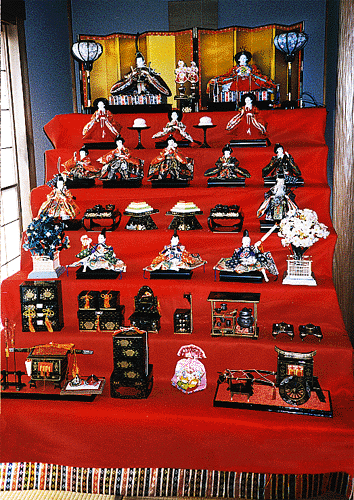 Hinamatsuri - March 3
Hinamatsuri - March 3 Hinamatsuri - March 3
Hinamatsuri - March 3
![]() What's the meaning of this event?
What's the meaning of this event?
Hinamatsuri is a seasonal festival (called sekku) on
March 3. Also it is considered as a day for girls, most families with
girls celebrate it for praying their health and happiness.
![]() Are there objects associated with this event?
Are there objects associated with this event?
People display Hina-ningyou (the special dolls which are only
for this festival), offer hishi-mochi
(red, white, and green lozenge-shaped rice cakes) and peach blossoms
and celebrate the festival with drinking shiro-zake (sweet
white sake).
 Dolls on a tier stand
Dolls on a tier stand
 Hishi-mochi
Hishi-mochi
![]() What's the history of this event?
What's the history of this event?
Unexpectedly, however, the custom of the festival is not so old.
Originally, Hinamatsuri was mostly celebrated in cities, but
after the Meiji Era, 1868-1912, when hina-ningyou were
merchandized, this custom became widespread across the whole country
and became the main event of the sekku in March.
On the other hand, a custom called Hina-okuri, in which people float paper dolls down rivers late on the afternoon of March 3, still exists in various areas. Also in some localities on this festival, children play outdoor games or play with dolls.
Probably, the origin of Hinamatsuri is this Nagashi-bina (floating paper dolls down a river). Originally, the paper dolls were made to represent each person and all the ill-fortunes that might visit that person in the coming year were wished onto the doll. Then the doll was sent away on the river, taking the bad luck with it.
 Here is very famous song which is
related with this event. It is called "
Hinamatsuri (Doll's festival)." Please hear and practice
it!
Here is very famous song which is
related with this event. It is called "
Hinamatsuri (Doll's festival)." Please hear and practice
it!
![[Jan]](../pictures/Jan.gif) ![[Feb]](../pictures/Feb.gif) ![[Mar]](../pictures/Mar.gif) ![[Apr]](../pictures/Apr.gif) ![[May]](../pictures/May.gif) ![[Jun]](../pictures/Jun.gif) ![[Jul]](../pictures/Jul.gif) ![[Aug]](../pictures/Aug.gif) ![[Sep]](../pictures/Sep.gif) ![[Oct]](../pictures/Oct.gif) ![[Nov]](../pictures/Nov.gif) ![[Dec]](../pictures/Dec.gif) |
![[JP NET Home]](http://web.mit.edu/jpnet/graphics/jpnethome.gif)
|
Date last modified: Tuesday, 05-Mar-2002 16:50:02 EST
Copyright 2002 Massachusetts Institute of Technology
This page's URL: http://web.mit.edu/jpnet/holidays/Mar/hinamaturi.shtml
Report any problems with this website here.